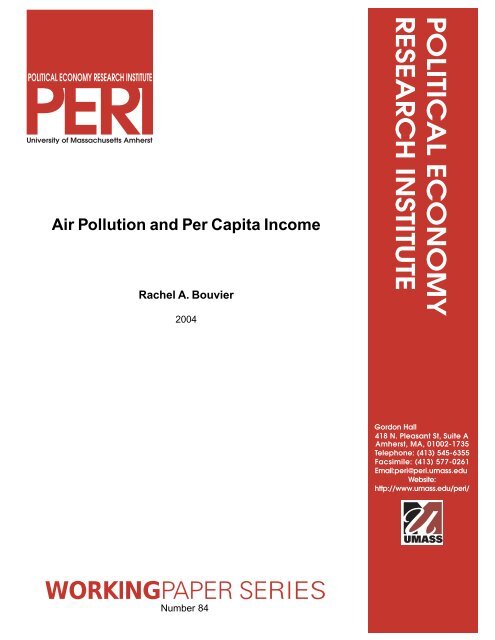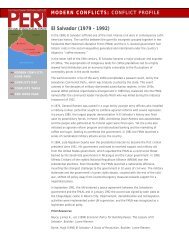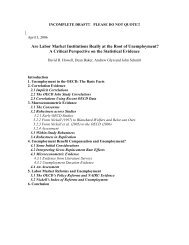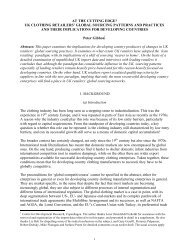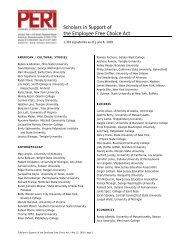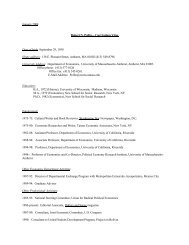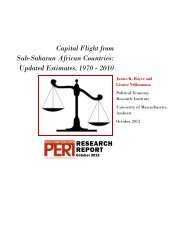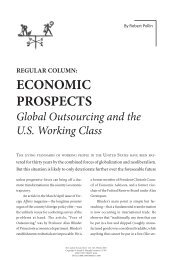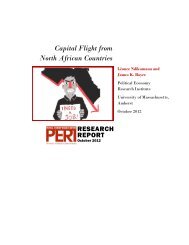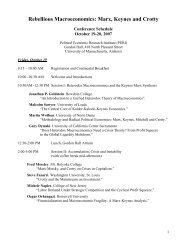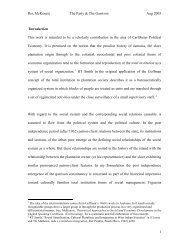Air Pollution and Per Capita Income - Political Economy Research ...
Air Pollution and Per Capita Income - Political Economy Research ...
Air Pollution and Per Capita Income - Political Economy Research ...
Create successful ePaper yourself
Turn your PDF publications into a flip-book with our unique Google optimized e-Paper software.
POLITICAL ECONOMY RESEARCH INSTITUTE<br />
University of Massachusetts Amherst<br />
Deepening Divides in Jobless Recovery<br />
<strong>Air</strong> <strong>Pollution</strong> <strong>and</strong> <strong>Per</strong> <strong>Capita</strong> <strong>Income</strong><br />
Rachel A. Bouvier<br />
2004<br />
Robert Pollin<br />
POLITICAL ECONOMY<br />
RESEARCH INSTITUTE<br />
2004<br />
Gordon Hall<br />
418 N. Pleasant St, Suite A<br />
Amherst, MA, 01002-1735<br />
Telephone: (413) 545-6355<br />
Facsimile: (413) 577-0261<br />
Email:peri@peri.umass.edu<br />
Website:<br />
http://www.umass.edu/peri/<br />
WORKINGPAPER SERIES<br />
Number 82 84
AIR POLLUTION AND PER CAPITA INCOME:<br />
A Disaggregation of the Effects of Scale, Sectoral Composition,<br />
<strong>and</strong> Technological Change<br />
Rachel A. Bouvier<br />
Department of Economics<br />
Wellesley College<br />
June 2004<br />
Abstract<br />
During the last decade, researchers have investigated the relationship between per capita<br />
income <strong>and</strong> environmental quality. This paper disaggregates the relationship between per<br />
capita income <strong>and</strong> emissions of carbon monoxide, carbon dioxide, sulfur dioxide, <strong>and</strong><br />
volatile organic compounds into scale, composition <strong>and</strong> technology effects, using data<br />
from European <strong>and</strong> North American countries from the period 1980-1986. Results<br />
indicate that the scale effect outweighs the composition <strong>and</strong> technology effects in the<br />
cases of carbon dioxide <strong>and</strong> volatile organic compounds, while the opposite is true in the<br />
cases of carbon monoxide <strong>and</strong> sulfur dioxide. The results also suggest that greater<br />
democracy is associated with lower emissions of all four pollutants.<br />
Key words: Environmental Kuznets curve; emissions; carbon monoxide; carbon dioxide;<br />
sulfur dioxide; volatile organic compounds.
1<br />
1. Introduction<br />
In 1992, researchers at the World Bank profiled how six environmental problems,<br />
ranging from carbon dioxide emissions to the percentage of the population without access<br />
to safe drinking water, respond to changes in per capita income. They described three<br />
distinct patterns: some environmental problems worsened as per capita income increased<br />
(municipal wastes per capita <strong>and</strong> carbon dioxide emissions per capita); some improved<br />
along with per capita income (the percentage of the population without safe water or<br />
adequate sanitation, <strong>and</strong> concentrations of airborne particulate matter); <strong>and</strong> some initially<br />
worsened <strong>and</strong> then eventually began to improve (concentrations of sulfur dioxide) (World<br />
Bank, 1992:11).<br />
Curiously, it is the latter which has most captured the attention of many economists <strong>and</strong><br />
policy makers. The “inverted U” described by the trajectory of sulfur dioxide<br />
concentrations against per capita income – called the “environmental Kuznets curve” due<br />
to its similarity to the theoretical relationship between per capita income <strong>and</strong> inequality<br />
first suggested by Kuznets (1955) – has been used incautiously by some to conclude that<br />
“in the end the best – <strong>and</strong> probably the only – way to attain a decent environment … is to<br />
become rich” (Beckerman, 1992).<br />
Tempting as it may be to arrive at this conclusion, it would be unwise for several reasons.<br />
First, as the World Bank found, the phenomena that fall into the “inverted-U” category<br />
represent only a subset of environmental problems. Second, as Arrow et al. (1995:520)<br />
point out, the inverted U does not “constitute evidence that it [the decline of pollution]<br />
will…happen in time to avert the important <strong>and</strong> irreversible global consequences of<br />
growth.” Third, as Grossman <strong>and</strong> Krueger (1995) state, there is nothing automatic about<br />
relationships that have proven true – in some places – in the past. While pollution levels<br />
may have declined after some turning point in some developed countries as per capita<br />
income grew, this does not necessarily imply that the same can or will occur in<br />
developing countries. For this reason, one must consider the underlying reasons behind<br />
such a curve, where it exists.<br />
The empirical literature on the environmental Kuznets curve typically is based on<br />
reduced-form equations that estimate the net effect of per capita income on pollution.<br />
Grossman <strong>and</strong> Krueger distinguish three effects that mediate this relationship, but they do<br />
not attempt to disentangle them empirically. This paper is an effort to do so, first by<br />
separating out the scale effect <strong>and</strong> then by investigating the impacts of variables related to<br />
the composition <strong>and</strong> technology effects. The next section describes each of these effects<br />
in turn. Section 3 then presents the econometric model to be used. Section 4 discusses the<br />
data, Section 5 summarizes the results, <strong>and</strong> Section 6 concludes.
2<br />
2. The Scale, Composition, <strong>and</strong> Technology Effects<br />
The scale effect arises from the simple fact that economies with higher per capita<br />
incomes both produce <strong>and</strong> consume more goods <strong>and</strong> services. Holding output mix <strong>and</strong><br />
production techniques constant, an increase in scale necessarily brings about a<br />
proportionate increase in pollution.<br />
Generally, however, as per capita income grows, both the output mix <strong>and</strong> production<br />
techniques change. Depending on the direction of these changes, a given unit of income<br />
may be associated with less or more pollution. If the scale effect is outweighed by<br />
pollution-reducing composition <strong>and</strong>/or technology effects, total pollution will fall with<br />
rising income. The scale effect can be expected to track year-to-year changes in the level<br />
of output <strong>and</strong> income, rising <strong>and</strong> falling with business cycle fluctuations, but the latter<br />
effects can be expected to operate more gradually.<br />
In the industrialized countries, economic growth has been accompanied by a shift in<br />
consumption patterns from the more material- <strong>and</strong> energy-intensive manufacturing sector<br />
toward the (theoretically) more environmentally-friendly service sector (Jayadevappa <strong>and</strong><br />
Chhatre, 2000: 178). In addition, international trade permits a country’s production<br />
patterns to diverge from its consumption patterns, as its citizens consume goods produced<br />
in other countries <strong>and</strong> produce goods consumed elsewhere. Both can contribute to the<br />
“composition effect” of rising per capita incomes.<br />
The technology effect allows for the possibility that as countries develop, “cleaner”<br />
technologies substitute for “dirtier” ones in the production of any given commodity. As a<br />
result, pollution per unit of output could decline while holding the output mix constant. If<br />
the technology effect were sufficiently strong, total pollution could decline even as output<br />
rises.<br />
The technology effect can be separated into two elements. One is the “autonomous”<br />
technology effect, in which the substitution of cleaner processes occurs more or less<br />
automatically for exogenous reasons. The other is the “induced” technology response,<br />
whereby dem<strong>and</strong> for a cleaner environment is translated into public <strong>and</strong> private decisions<br />
to cut pollution. 1 Technological change in response to regulatory m<strong>and</strong>ates, such as<br />
compulsory installation of end-of-pipe scrubbers in stacks to reduce sulfur dioxide<br />
emissions, is an example. The possibility of such induced technology responses suggests<br />
that an important intervening variable in the income-pollution relation may be the extent<br />
of democracy, such that dem<strong>and</strong> for environmental quality is politically effective (see<br />
1 This builds on Hicks’ (1939) distinction between technological change brought about by changes in the<br />
relative price of factors (induced technological change) versus exogenous growth in scientific <strong>and</strong> technical<br />
knowledge. For a comprehensive literature survey on induced versus autonomous technological change<br />
<strong>and</strong> environmental quality, see Jaffe et al. (1995).
3<br />
Barrett <strong>and</strong> Graddy, 2000; Torras <strong>and</strong> Boyce, 1998). For this reason, the induced<br />
technology response is sometimes called the “political economy” effect (Heerink et al,<br />
2001).<br />
To advance our underst<strong>and</strong>ing of the relationship between environmental degradation <strong>and</strong><br />
per capita income, it would be useful to be able to distinguish empirically among the<br />
scale, composition, <strong>and</strong> technology effects, <strong>and</strong> to assess their relative strength. Stern<br />
(2002) attempts to measure the composition effect by including variables measuring the<br />
value-added shares of agriculture, manufacturing, <strong>and</strong> other sectors as determinants of<br />
pollution; to proxy the technology effect he uses total energy inputs. Once these are<br />
included, he treats the estimated coefficient on per capita income as a measure of the<br />
scale effect. Baldson (2003) interacts measures of the degree of democracy with per<br />
capita income to assess the technology effect, reasoning that “‘abatement’ (technique)<br />
effects are fundamentally interacted with government in a way that ‘gross emissions’ (or<br />
scale) are not, leading to an econometric specification capable of identifying them<br />
separately.” However, he makes no attempt to identify the composition effect. In this<br />
paper, I propose an alternative methodology for disaggregating the three effects.<br />
3. A Disaggregated Model of the <strong>Income</strong>-Degradation Relationship<br />
3.1 Trend versus fluctuations<br />
I begin by estimating separately the environmental impact of the trend in GDP <strong>and</strong> that of<br />
fluctuations around that trend. The composition <strong>and</strong> technology effects are assumed to<br />
operate only through the trend: they are expected to affect the income-degradation<br />
relation gradually, with little sensitivity to year-to-year income fluctuations. The scale<br />
effect, on the other h<strong>and</strong>, is apparent in the effects of the year-to-year fluctuations in<br />
income around that trend. These short-run variations in GDP, unlike long-run growth, are<br />
not expected to alter substantially the composition of output or technology.<br />
Figure 1 depicts the per capita income in a hypothetical country where it trends upward in<br />
a linear fashion. The curved line indicates the observed level of per capita GDP; the<br />
dashed line indicates the level predicted by the time trend.<br />
Previous econometric models of the relationship between per capita income <strong>and</strong><br />
emissions have used (Y it ), the observed income in country i at time t, as the independent<br />
variable. Decomposing this into fluctuations <strong>and</strong> trend, we can obtain two independent<br />
variables: Y it *, the trend level of income, <strong>and</strong> (Y it – Y it *), the fluctuations around that<br />
trend. The impact of income fluctuations on environmental degradation can be attributed<br />
to the scale effect, while the impact of the income trend is attributable not only to the<br />
changes in the scale but also to composition <strong>and</strong> technology effects.
Y t<br />
trend of GDP over time<br />
Y* t<br />
Y<br />
Figure 1: Trend versus fluctuation of income<br />
t<br />
time<br />
3.2 Model<br />
The full econometric model estimated in this paper is:<br />
lnPol it = α + β 1 lnY it * + β 2 (lnY it *) 2 + β 3 ln(Y it - Y it *) + β 4 (Pop it /km 2 ) +β 5 (Pop it /km 2 ) 2 +<br />
+ β 6 (I it /S it )+ β 7 DEMOC it + β i ID i +µ it (1)<br />
where:<br />
Pol it = the per capita emissions level;<br />
Y it *= the trend value of income; 2<br />
Y it = the actual value of per capita GDP;<br />
Pop it /km 2 = population per kilometer squared;<br />
I it = the percentage of GDP that comes from value added in the industrial<br />
S it = the percentage of GDP that comes from value added in the service sector<br />
DEMOC it is an index of democracy<br />
ID i = country-specific dummy variables;<br />
µ it is the error term, whose properties will be discussed below;<br />
<strong>and</strong> the subscripts i <strong>and</strong> t refer to the country <strong>and</strong> year, respectively.<br />
Equation (1) implies that the pollution level can be explained by the income trend,<br />
income fluctuations, sectoral composition of output (I it /S it ), <strong>and</strong> the democracy index,<br />
2 The income trend variable is obtained by regressing the log of per capita GDP on the year <strong>and</strong> year<br />
squared, <strong>and</strong> obtaining the fitted values. The income fluctuations are the residuals of this equation.
5<br />
with population density included as a control variable. 3 The equation will be estimated by<br />
feasible generalized least squares.<br />
The scale effect is estimated as a constant elasticity by the coefficient β 3 . The elasticity of<br />
emissions with respect to the trend level of income is estimated by the following<br />
equation:<br />
ε ey = β 1 + 2(β 2 )[mean (lnY)] (2)<br />
The trend elasticity captures the scale, composition <strong>and</strong> technology effects combined.<br />
Hence, (ε ey - β 3 ) gives an estimate of the effects of composition <strong>and</strong> technology. The<br />
sectoral composition variable is added in an effort to isolate the composition effect;<br />
insofar as it does so, (ε ey - β 3 ) provides an estimate of the technology effect alone. The<br />
democracy variable is added in an effort to further separate out the induced “political<br />
economy” component of the technology effect. Insofar as it does so, the value of (ε ey - β 3 )<br />
provides an estimate of the autonomous component of the technology effect alone.<br />
The strength of the induced technology effect may differ by pollutant: it can be expected<br />
to be stronger for pollutants that have greater visibility – literally <strong>and</strong> metaphorically –<br />
<strong>and</strong> hence are more subject to public dem<strong>and</strong> for emissions reductions. This study<br />
investigates four different pollutants: carbon dioxide, carbon monoxide, sulfur dioxide,<br />
<strong>and</strong> volatile organic compounds. The characteristics of each are discussed in the next subsection.<br />
3.3 Discussion of pollutants studied<br />
The pollutants investigated in this study – carbon monoxide, carbon dioxide, sulfur<br />
dioxide, <strong>and</strong> volatile organic compounds – were chosen because of their contrasting<br />
characteristics, as well as the fact that data on emissions are available for a large number<br />
of industrialized countries. <strong>Pollution</strong> is measured in metric tons of emissions per capita.<br />
Some studies of the income-degradation relationship have used ambient concentrations,<br />
rather than emissions, as the dependant variable. Both measures have advantages <strong>and</strong><br />
drawbacks. If the goal is to study how environmental quality changes with economic<br />
growth, then ambient concentrations are a preferable measure for localized pollutants.<br />
However, ambient concentrations are affected by geographical variables such as<br />
topography, climate, <strong>and</strong> wind. For example, the existence of hills or thermal inversions<br />
may limit dispersion of contaminants. The fact that ambient concentrations vary from<br />
place to place within any given country makes determining the appropriate measure for<br />
3 Population density has been used in other studies of air pollution (see, for example, Selden <strong>and</strong> Song,<br />
1994), as sparsely populated countries may be less likely to consider lowering per capita emissions as a<br />
priority.
6<br />
national-level analysis problematic. 4 Moreover, for globalized pollutants such as CO 2 , the<br />
level of emissions is the only appropriate measure.<br />
3.3.1 Carbon monoxide<br />
Carbon monoxide (CO) is a colorless, odorless gas, arising from the incomplete burning<br />
of fossil fuels (OSHA, 2002). In the United States, emissions of carbon monoxide<br />
generally decreased from 1970 to 1995, but then increased again (World Almanac Book<br />
of Facts, 2003:166). The atmospheric concentration of carbon monoxide in the U.S.<br />
nonetheless continued to decline, possibly because increased ultraviolet radiation, due to<br />
the thinning of the ozone layer, creates hydroxyl radicals that react rapidly with carbon<br />
monoxide (Khalil, 1995: 7).<br />
Although carbon dioxide <strong>and</strong> carbon monoxide both arise from the combustion of fossil<br />
fuels, the contaminants exhibit different fates. Carbon dioxide persists in the atmosphere,<br />
whereas carbon monoxide remains in the atmosphere for an average of two months.<br />
Therefore, changes in emissions of carbon monoxide have a more rapid effect on<br />
atmospheric concentrations. Although carbon monoxide is odorless <strong>and</strong> colorless, its<br />
localized health effects (shortness of breath <strong>and</strong> dizziness, for example) make it a good<br />
c<strong>and</strong>idate for a strong political economy effect. In the U.S., for example, CO is among<br />
the “criteria air pollutants” regulated under the Clean <strong>Air</strong> Act of 1970.<br />
3.3.2 Carbon dioxide<br />
Carbon dioxide (CO 2 ), like its cousin, is a colorless, odorless gas, released from fossil<br />
fuel combustion. As one of the primary culprits in global warming, CO 2 is a pure “public<br />
bad” whose effects are not restricted by country boundaries. As such, it is subject to the<br />
international “free rider” problem: individual countries may not be willing to enforce<br />
controls on carbon dioxide emissions, as they would receive only a small fraction of the<br />
benefits while bearing the full costs. Therefore, the political economy effect may not be<br />
as strong for carbon dioxide as for some other more visible <strong>and</strong> localized contaminants.<br />
In the U.S., for example, the Environmental Protection Act does not attempt to regulate<br />
CO 2 emissions. 5 However, concern about global warming has been growing in the past<br />
decade or so. In the 2002 “Eurobarometer” (an extensive survey of the attitudes of<br />
Europeans towards their environment), 39% of those surveyed reported that they were<br />
“very worried” about climate change (EORG, 2002: 8). With the signing of the Kyoto<br />
Protocol, <strong>and</strong> subsequent discussions of “carbon taxes” in Europe, public awareness of<br />
carbon dioxide emissions is on an upswing in many countries.<br />
4 In addition, there is the issue of the spatial separation between emissions <strong>and</strong> concentrations: “Using<br />
emissions neither ‘punishes’ countries that import pollution from areas over which they have little political<br />
control nor ‘rewards’ those that export pollution via prevailing winds” (Scruggs, 1998: 296).<br />
5<br />
In fact, under the current administration, the U.S. EPA heavily edited a report on the state of the<br />
environment to include only cursory mention of global warming <strong>and</strong> climate change (Herbert, 2003).
7<br />
3.3.3 Sulfur dioxide<br />
Sulfur dioxide is a colorless gas with a pungent odor. It is formed when fuels containing<br />
sulfur (mainly coal <strong>and</strong> oil) are burned, <strong>and</strong> during various industrial processes, such as<br />
smelting. Short-term exposure to high levels of sulfur dioxide can be life-threatening.<br />
Long-term exposure to atmospheric sulfur dioxide can lead to or exacerbate asthma <strong>and</strong><br />
other respiratory illnesses, <strong>and</strong> aggravate existing heart disease (U.S. Environmental<br />
Protection Agency, 2003). In addition, sulfur dioxide is a precursor to acid rain, which<br />
leads to the corrosion of buildings, monuments, <strong>and</strong> other structures, <strong>and</strong> has adverse<br />
impacts on forests <strong>and</strong> aquatic ecosystems.<br />
Sulfur dioxide in the atmosphere is highly visible (politically speaking) <strong>and</strong> thus is a<br />
prime c<strong>and</strong>idate for an induced policy response. However, public interest <strong>and</strong> concern<br />
about acid rain has been declining over the last decade, in both the United States (Gallup<br />
et al., 2000) <strong>and</strong> Europe (EORG, 2002: 8). In addition, because SO 2 can be transported<br />
long distances, there is potential for transboundary separation between the point of origin<br />
<strong>and</strong> the point of impact, diminishing the likelihood of an effective political economy<br />
effect.<br />
3.3.4 Volatile organic compounds<br />
Volatile organic compounds (VOCs), a class of volatile (easily evaporating) carboncontaining<br />
compounds such as carbon tetrachloride, trichloroethene (TCE) <strong>and</strong> benzene,<br />
are found in many solvents <strong>and</strong> paints used in industrial activities <strong>and</strong> many household<br />
items. Unless disposed of properly, VOCs can enter the air, soil, <strong>and</strong> water, where they<br />
can remain for years (Brookhaven National Laboratories, 2002). The dispersion of<br />
sources of VOCs, compared to those of sulfur dioxide, may make their emissions more<br />
difficult to control. In addition, VOCs may be less visible in the public’s perception,<br />
possibly muting any political economy effect.<br />
3.4 Hypotheses<br />
Equation (1) will be estimated first without the sectoral composition <strong>and</strong> democracy<br />
variables. <strong>Income</strong> fluctuations are expected to have a positive coefficient, here interpreted<br />
as an estimate of the scale effect. If pollution exhibited constant returns to scale, the<br />
elasticity of emissions with respect to income fluctuations would be 1.0. It is possible,<br />
however, that emissions have both a fixed component that is more or less inelastic with<br />
respect to income fluctuations, as well as a variable component with approximately unit<br />
elasticity. If so, the estimated elasticity (which can be read directly from the coefficient in<br />
this specification since both variables are in natural logarithms) would be between zero<br />
<strong>and</strong> one. The elasticity of emissions with respect to the trend level of income is expected<br />
to be negative (meaning that the income trend is favorable for environmental quality) if<br />
the composition <strong>and</strong> technology effects outweigh the scale effect, <strong>and</strong> positive if they do<br />
not.
8<br />
Next, the full model will be estimated in an effort to isolate some phenomena that<br />
contribute to the trend effect. The predicted sign on the sectoral composition variable is<br />
positive; that is, a higher ratio of industrial sector output to service sector output is<br />
expected to result in higher levels of emissions. The predicted sign on the democracy<br />
variable is negative; that is, countries with greater democracy (<strong>and</strong> a more equitable<br />
distribution of political power) are expected to have lower levels of emissions. The<br />
strength of this effect is expected to vary across pollutants, however, for the reasons<br />
discussed above. A typology of the pollutants <strong>and</strong> their likely political “responsiveness”<br />
(defined as how likely emissions are to elicit politically effective dem<strong>and</strong> for pollution<br />
reduction) is presented in Table 1. The inclusion of the sectoral composition <strong>and</strong><br />
democracy variables in the estimated equations is expected to reduce the difference<br />
between the elasticities of emissions with respect to the income trend <strong>and</strong> with respect to<br />
income fluctuations. Some difference is expected to remain, however, insofar as the trend<br />
effect also reflects autonomous technological change, <strong>and</strong> because the sectoral <strong>and</strong><br />
democracy variables used here may be imperfect proxies for the composition <strong>and</strong><br />
political economy effects.<br />
3.5 Issues in Estimation<br />
Equation (1) is estimated by a fixed-effects method. That is, each country is assumed to<br />
have its own intercept, while the slope coefficients are common to all countries. A logratio<br />
test was used to test for heteroskedasticity across panels: the model was estimated<br />
with <strong>and</strong> without correcting for panel-level heteroskedasticity, <strong>and</strong> their log ratios then<br />
compared. Evidence was found for panel-level heteroskedasticity; hence, the corrected<br />
results are reported here.<br />
First-order serial autocorrelation within panels can also be a problem. Durbin Watson<br />
tests were performed on the data for individual countries, <strong>and</strong> evidence of first-order<br />
serial autocorrelation was found in a number of cases. Hence, the feasible generalized<br />
least squares method was used to estimate the model.
9<br />
Table 1: Likely <strong>Political</strong> <strong>Economy</strong> Effect of Various <strong>Air</strong> Emissions<br />
Pollutant Sources Hazards Public Good Nature Likely Sensitivity to<br />
<strong>Political</strong> <strong>Economy</strong> Effect<br />
Carbon dioxide<br />
Fossil fuel combustion, cement<br />
manufacture, waste combustion,<br />
paper processing.<br />
Main component of “greenhouse<br />
gases,” which contribute to<br />
global warming.<br />
Close to a pure international<br />
public “bad.”<br />
Weak.<br />
Sulfur dioxide<br />
Carbon monoxide<br />
Volatile organic<br />
compounds<br />
Formed when fuel containing<br />
sulfur (mainly coal <strong>and</strong> oil) is<br />
burned. Mainly accounted for by<br />
fuel combustion in large coalfired<br />
plants.<br />
Automobile emissions;<br />
home/building heating, cement<br />
manufacture, paper processing;<br />
natural sources.<br />
Paints, paint strippers, <strong>and</strong> other<br />
solvents; wood preservatives;<br />
aerosol sprays; cleansers <strong>and</strong><br />
disinfectants; moth repellents<br />
<strong>and</strong> air fresheners; stored fuels<br />
<strong>and</strong> automotive products; hobby<br />
supplies; dry-cleaned clothing.<br />
Short term: temporary breathing<br />
problems in asthmatics.<br />
Long term: respiratory illness,<br />
aggravation of existing<br />
cardiovascular problems, <strong>and</strong><br />
acid rain.<br />
Weakens heart contractions;<br />
drowsiness; shortness of breath<br />
<strong>and</strong> chest pain; headaches, rapid<br />
breathing, blurred vision, lack of<br />
coordination, nausea, dizziness,<br />
confusion <strong>and</strong> impaired<br />
judgment.<br />
Eye, nose, <strong>and</strong> throat irritation;<br />
headaches, loss of coordination,<br />
nausea; damage to liver, kidney,<br />
<strong>and</strong> central nervous system.<br />
Some organics can cause cancer<br />
in animals; some are suspected or<br />
known to cause cancer in<br />
humans.<br />
Strong local effects. Can<br />
combine with other particles<br />
to be transported long<br />
distances.<br />
Strong local effects.<br />
Strong local effects; may<br />
also contribute to global<br />
warming.<br />
Strong.<br />
Strong.<br />
Indeterminate – effects may<br />
not be immediate; difficulty<br />
in pinpointing source of<br />
emissions.
10<br />
4. Data<br />
4.1 <strong>Pollution</strong> data<br />
<strong>Pollution</strong> data for the years 1980 to 1996 were obtained from the World Resources<br />
Institute’s Earth Information Portal (2002). 6 Emissions are divided by the population of<br />
the country to obtain per capita emissions.<br />
The available data include only European countries, Canada, <strong>and</strong> the United States –<br />
countries that reported their emissions to the Economic Commission for Europe whose<br />
per capita incomes (in 1987 PPP–adjusted dollars) range from $1100 to $24,371. 7 Hence,<br />
one should be cautious about extrapolating the results to other countries. The country<br />
coverage varies by contaminant; Appendix Table 1 shows the countries covered by each<br />
database.<br />
4.2 Economic <strong>and</strong> political variables<br />
Data on the per capita level of GDP, adjusted for purchasing power parity, 8 also come<br />
from the World Resources Institute’s Earth Information Portal (2002), as do the<br />
democracy <strong>and</strong> population variables. The original data for the democracy index – a<br />
weighted measure of the competitiveness <strong>and</strong> openness of executive recruitment, the<br />
degree of limitations on the chief executive, <strong>and</strong> the competitiveness of political<br />
participation - are from the Polity IV project at the University of Maryl<strong>and</strong>. 9 The<br />
composition variable, which measures the value added in the industrial sector relative to<br />
that in the service sector, comes from the World Bank’s World Development Indicators,<br />
1999. Summary statistics <strong>and</strong> correlation coefficients for all variables are reported in<br />
Tables 2 <strong>and</strong> 3, respectively.<br />
6 Carbon dioxide emissions figures come from the International Energy Agency, using the Reference<br />
Approach. This approach estimates the carbon content in primary fuels supplied to the economy. Apparent<br />
consumption of these fuels is derived by subtracting net exports from production, <strong>and</strong> accounting for net<br />
changes in stocks. “Double-counting” is avoided by not including the carbon contained in secondary fuels,<br />
but imports <strong>and</strong> exports of those fuels are included (see World Resources Institute, “Technical Notes”).<br />
7 Data for carbon dioxide emissions are available for other countries, but for the sake of comparability, I<br />
analyze only those countries for which emissions data were found for at least one of the other<br />
contaminants.<br />
8 The purchasing power parity adjustment ensures that countries with similar “real” income can purchase<br />
similar amounts <strong>and</strong> qualities of goods <strong>and</strong> services.<br />
9 For detail, see (Marshall <strong>and</strong> Jaggers, 2002). The regime is coded for degree of democracy on a scale<br />
from 0 to 10, <strong>and</strong> for the degree of autocracy from 0 to 10. The variable used here is constructed by<br />
subtracting the autocracy score from the democracy score.
11<br />
Table 2: Summary Statistics<br />
Carbon Monoxide Sample<br />
Obs Mean Std. Dev. Min Max<br />
CO (metric tons per 100 people) 325 14.65 8.75 2.25 52.29<br />
GDP (adjusted for PPP, hundreds of international 325 109.25 55.64 12.32 243.71<br />
1987$ per person)<br />
Industry / Service value added 272 0.76 0.47 0.25 2.30<br />
Democracy index 280 8.45 4.12 -8 10<br />
Carbon Dioxide Sample<br />
Obs Mean Std. Dev. Min Max<br />
CO 2 (metric tons per 100 people) 368 887.6 372.7 73.9 2,097.3<br />
GDP (adjusted for PPP, hundreds of international 368 115.72 49.71 11.06 209.74<br />
1987$ per person)<br />
Industry / Service value added 330 0.70 0.45 0.25 2.77<br />
Democracy index 350 8.92 3.17 -7 10<br />
Sulfur Dioxide Sample<br />
Obs Mean Std. Dev. Min Max<br />
SO 2 (metric tons per 100 people) 434 0.598 0.453 0.008 2.70<br />
GDP (adjusted for PPP, hundreds of international 434 106.83 53.40 12.32 243.71<br />
1987$ per person)<br />
Industry / Service value added 350 0.78 0.47 0.34 2.30<br />
Democracy index 376 8.22 4.49 -8 10<br />
Volatile Organic Compounds Sample<br />
Obs Mean Std. Dev. Min Max<br />
VOC (metric tons per 100 people) 344 0.381 0.218 0.002 1.10<br />
GDP (adjusted for PPP, hundreds of international 344 103.78 57.31 12.32 243.71<br />
1987$ per person)<br />
Industry / Service value added 277 0.76 0.45 0.25 2.21<br />
Democracy index 298 7.91 4.83 -8 10
12<br />
Table 3: Correlation Coefficients<br />
Carbon Monoxide<br />
<strong>Income</strong><br />
<strong>Income</strong> Trend Fluctuations Ind/Serv Democracy<br />
<strong>Income</strong> Trend 1<br />
<strong>Income</strong><br />
Fluctuations 1.61E-02 1<br />
Industry/Service<br />
Value Added -0.724 7.33E-02 1<br />
Democracy 0.516 -0.108 -0.739 1<br />
Carbon Dioxide<br />
<strong>Income</strong> Trend<br />
<strong>Income</strong><br />
Fluctuations Ind/Serv Democracy<br />
<strong>Income</strong> Trend 1<br />
<strong>Income</strong><br />
Fluctuations 3.80E-03 1<br />
Industry/Service<br />
Value Added -0.661 2.79E-02 1<br />
Democracy 0.542 -0.055 -0.825 1<br />
Sulfur Dioxide<br />
<strong>Income</strong> Trend<br />
<strong>Income</strong><br />
Fluctuations Ind/Serv Democracy<br />
<strong>Income</strong> Trend 1<br />
<strong>Income</strong><br />
Fluctuations 1.49E-02 1<br />
Industry/Service<br />
Value Added -0.731 8.56E-02 1<br />
Democracy 0.539 -0.096 -0.737 1<br />
Volatile Organic Compounds<br />
<strong>Income</strong> Trend<br />
<strong>Income</strong><br />
Fluctuations Ind/Serv Democracy<br />
<strong>Income</strong> Trend 1<br />
<strong>Income</strong><br />
Fluctuations 4.40E-03 1<br />
Industry/Service<br />
Value Added -0.708 0.111 1<br />
Democracy 0.526 -0.145 -0.711 1<br />
5. Results<br />
Regression results for each of the four contaminants are reported in Tables 4 through 7.<br />
5.1 Carbon monoxide<br />
In the case of carbon monoxide (Table 4), the estimated coefficient on the trend of<br />
income is positive <strong>and</strong> the coefficient on the square of the trend level of income is<br />
negative in all specifications. This implies an inverted-U relationship: as the trend level
13<br />
of per capita income increases, per capita carbon monoxide emissions at first increase <strong>and</strong><br />
then decrease. The turning point at which per capita carbon monoxide emissions begin to<br />
decrease occurs at about $7,300 (in 1987 international dollars), a level corresponding to<br />
Slovenia’s mean income over the period. Many countries in the sample had per capita<br />
incomes beyond this point. 10<br />
Table 4: Effect of <strong>Income</strong>, Composition, <strong>and</strong> Democracy on Carbon Monoxide Emissions<br />
MODEL 1 MODEL 2 MODEL 3 MODEL 4 MODEL 5<br />
<strong>Income</strong> Trend 4.27 *** 2.52 *** 2.15 *** 2.77 *** 2.08 ***<br />
<strong>Income</strong> Trend -0.50 *** -0.24 *** -0.20 *** -0.26 *** -0.19 *<br />
Squared<br />
Fluctuations 0.25 *** 0.13 # 0.12 0.14 # 0.14<br />
Population<br />
-6.86E-02 *** -5.91E-02 *** -7.31E-02 *** -6.70E-02 ***<br />
Density<br />
Population<br />
5.66E-05 *** 4.57E-05 *** 6.11E-05 *** 5.40E-05 ***<br />
Density<br />
Squared<br />
Industrial /<br />
0.15 *** 8.86E-02 #<br />
Service Value<br />
Added<br />
Democracy -1.04E-02 *** -1.02E-02 **<br />
N 325 242 215 238 211<br />
# Countries 30 27 24 26 23<br />
Wald Statistic 3214.81 *** 7954.61 5922.48 6909 5692.77<br />
Df 32 31 29 31 29<br />
*** indicates statistical significance at the 0.005 level<br />
** indicates statistical significance at the 0.01 level<br />
*indicates statistical significance at the 0.05<br />
# indicates statistical significance at the 0.1 level<br />
As expected, the coefficient on income fluctuations is positive, <strong>and</strong> it is statistically<br />
significant at the 10 percent level. A one percent fluctuation in income is associated with<br />
a 0.12 to 0.25 percent change in carbon monoxide emissions. The finding that this proxy<br />
for the scale effect is well below unit elasticity implies that CO emissions have a<br />
substantial fixed component. The population density variable is negative, again as<br />
expected, with the positive coefficient on the squared term of population density<br />
indicating that this effect is non-linear.<br />
The income trend coefficient captures the technology <strong>and</strong> composition effects in addition<br />
to scale. The inclusion of the sectoral composition <strong>and</strong> democracy variables was an<br />
attempt to isolate some of the factors that contribute to these effects. The composition<br />
10 Selden <strong>and</strong> Song (1994) similarly found a turning point for carbon monoxide emissions of $6,241 in<br />
1985 US$.
14<br />
effect is positive, as hypothesized, <strong>and</strong> statistically significant, implying that the higher<br />
the ratio of value added in the industrial sector relative to that of the service sector, the<br />
higher the level of carbon monoxide emissions. The democracy index is negative <strong>and</strong><br />
statistically significant, implying that all else being equal, the stronger a country’s<br />
democracy, the lower its per capita emissions. The inclusion of the democracy <strong>and</strong><br />
composition variables does not have much effect, however, on the income trend<br />
coefficient. This implies either that these proxies imperfectly capture the composition <strong>and</strong><br />
political economy effects, or that the autonomous technology effects are relatively strong.<br />
The estimated elasticity of carbon monoxide emissions with respect to the trend level of<br />
income is –0.33 in model 1, when calculated at the means, implying that a one percent<br />
increase in the trend level of income leads to a 0.33 percent decrease in emissions. The<br />
elasticity of emissions with respect to the fluctuations in income is 0.25 in this model,<br />
implying that a one percent increase in income is related to a 0.25 percent increase in<br />
pollution. The impact of income fluctuations is assumed to reflect purely the scale effect,<br />
since short-run fluctuations in income are unlikely to entail significant changes in the<br />
sectoral composition of output or in technology. The impact of the income trend, by<br />
contrast, reflects not only the scale effect but also the technology effect (both induced <strong>and</strong><br />
autonomous) <strong>and</strong> the composition effect. Subtracting the elasticity of emissions with<br />
respect to the short-term income fluctuations from the elasticity with respect to the<br />
income trend gives an estimate of the size of the composition <strong>and</strong> technology effects. In<br />
this case, this implies that the composition <strong>and</strong> technology effects combined have an<br />
elasticity of –0.58. Long-term changes in the structure of the economy <strong>and</strong> technology<br />
appear to have decreased carbon monoxide emissions in these countries, outweighing the<br />
scale effect.<br />
5.2 Carbon dioxide<br />
The political economy effect is expected to be relatively weak for carbon dioxide<br />
emissions, due to the global character of the associated externalities. The results for CO 2<br />
are shown in Table 5. The estimated coefficients on the income trend <strong>and</strong> its square again<br />
indicate an inverted-U relationship, which is consistent with other studies (see, for<br />
example, Stern (2002)). However, the turning point occurs at about $17,400 (in 1987<br />
international dollars), a level corresponding to the per capita income of the United States<br />
in the 1990s. The fact that the turning point occurs at so high a level of income does not<br />
bode well for those who hope that economic growth will reduce worldwide carbon<br />
dioxide emissions in the foreseeable future. The estimated coefficients on population<br />
density <strong>and</strong> the sectoral composition variable have the expected signs. When sectoral<br />
composition is included as an explanatory variable, the estimated coefficient on the<br />
democracy index is of marginal statistical significance (though it does have the expected<br />
negative sign).
16<br />
Table 5: Effect of <strong>Income</strong>, Composition, <strong>and</strong> Democracy on Carbon Dioxide Emissions<br />
MODEL 1 MODEL 2 MODEL 3 MODEL 4 MODEL 5<br />
<strong>Income</strong> Trend 2.92 *** 2.66 *** 1.78 *** 2.45 *** 1.91 ***<br />
<strong>Income</strong> Trend -0.28 *** -0.25 *** -0.16 *** -0.23 *** -0.18 ***<br />
Squared<br />
Fluctuations 0.42 *** 0.38 *** 0.40 *** 0.38 *** 0.40 ***<br />
Population<br />
Density -9.35E-03 * -5.11E-03 -1.10E-02 *** -7.33E-03<br />
Population<br />
Density<br />
Squared 1.12E-05 ** 7.35E-06 1.30E-05 *** 9.67E-06<br />
Industrial /<br />
Service Value<br />
Added 0.17 *** 0.13 ***<br />
Democracy -1.48E-02 *** -6.36E-03 #<br />
N 368 309 274 309 274<br />
# Countries 29 27 24 27 24<br />
Wald Statistic 16883.64 22193.91 21825.56 27764.27 22418.55<br />
Df 31 31 29 32 30<br />
*** indicates statistical significance at the 0.005 level<br />
** indicates statistical significance at the 0.01 level<br />
*indicates statistical significance at the 0.05 level<br />
# indicates statistical significance at the 0.1 level<br />
The estimated coefficients on the income trend variables in model 1 imply an elasticity of<br />
carbon dioxide emissions with respect to changes in the trend level of income of 0.31.<br />
This indicates that as the trend level of income increases, carbon dioxide emissions<br />
increase by 0.31 percent. The elasticity with respect to income fluctuations is 0.42.<br />
Following the logic explained above, this implies that the elasticity of carbon dioxide<br />
emissions with respect to the composition effect <strong>and</strong> the technology effect is –0.11,<br />
indicating that these effects do moderate carbon dioxide emissions somewhat in the longrun.<br />
However, in marked contrast to the findings for carbon monoxide, the composition<br />
<strong>and</strong> technology effects do not outweigh the scale effect.<br />
5.3 Sulfur dioxide<br />
The results support the hypothesis of a relatively strong political economy effect for<br />
sulfur dioxide (see Table 6). The coefficient on the democracy index is negative <strong>and</strong><br />
statistically significant. The coefficient on the sectoral composition variable is positive,<br />
as expected, <strong>and</strong> statistically significant in all specifications.
17<br />
Table 6: Effect of <strong>Income</strong>, Composition, <strong>and</strong> Democracy on Sulfur Dioxide Emissions<br />
MODEL 1 MODEL 2 MODEL 3 MODEL 4 MODEL 5<br />
<strong>Income</strong> Trend 8.18 *** 8.16 *** 7.40 *** 7.22 *** 6.62 ***<br />
<strong>Income</strong> Trend -1.01 *** -0.99 *** -0.99 *** -0.91 *** -0.91 ***<br />
Squared<br />
Fluctuations 0.42 *** 0.49 *** 0.31 * 0.39 *** 0.24 *<br />
Population Density -4.81E-02 *** 6.72E-04 -4.50E-02 *** 7.87E-04<br />
Population Density<br />
3.18E-05 *** -1.57E-05 2.90E-05 ** -1.54E-05<br />
Squared<br />
Industrial / Service<br />
0.37 *** 0.35 ***<br />
Value Added<br />
Democracy -1.35E-02 *** -9.57E-03 ***<br />
N 434 323 272 319 268<br />
# Countries 33 30 26 29 25<br />
Wald Statistic 1085.32 3426.17 3032.67 3942.46 3234.75<br />
Df 35 34 31 34 31<br />
*** indicates statistical significance at the 0.005 level<br />
** indicates statistical significance at the 0.01 level<br />
*indicates statistical significance at the 0.05 level<br />
# indicates statistical significance at the 0.1 level<br />
The coefficients on the income <strong>and</strong> income squared terms again describe an inverted-U<br />
relationship for sulfur dioxide emissions. The turning point occurs at $5,700 in 1987<br />
international dollars, a level of income roughly equivalent to that of Hungary. 11 In model<br />
1, the elasticity of sulfur dioxide emissions with respect to trend income is -0.93. The<br />
elasticity of sulfur dioxide emissions with respect to income fluctuations is 0.42. Hence<br />
the elasticity of emissions with respect to the composition <strong>and</strong> technology effects of<br />
income growth is –1.35. This indicates that the latter effects together have contributed to<br />
a substantial decrease in per capita sulfur dioxide emissions.<br />
5.4 Volatile organic compounds<br />
The results for volatile organic compounds, reported in Table 7, support the hypothesis<br />
that the political economy effect, as proxied by the estimated coefficient on the<br />
democracy index, will be weaker than in the case of sulfur dioxide. Nevertheless, it is<br />
statistically significant, with the expected sign. The estimated coefficient on the<br />
composition variable is positive <strong>and</strong> statistically significant, also as expected.<br />
11 Selden <strong>and</strong> Song (1994) estimated a turning point of $8,900 in 1985 US$; Grossman <strong>and</strong> Krueger (1995)<br />
arrived at a turning point of under $5,000, also in 1985 US$.
18<br />
Table 7: Effect of <strong>Income</strong>, Composition, <strong>and</strong> Democracy on Volatile Organic Compound Emissions<br />
MODEL 1 MODEL 2 MODEL 3 MODEL 4 MODEL 5<br />
<strong>Income</strong> Trend 3.28 *** 2.20 *** 1.71 *** 2.04 *** 1.61 ***<br />
<strong>Income</strong> Trend -0.35 *** -0.17 *** -0.12 * -0.16 * -0.12 #<br />
Squared<br />
Fluctuations 0.48 *** 0.26 *** 0.19 * 0.21 *** 0.18 *<br />
Population<br />
Density -5.16E-02 *** -6.75E-02 *** -4.83E-02 *** -7.09E-02 ***<br />
Population<br />
Density<br />
Squared 4.20E-05 *** 6.24E-05 *** 3.86E-05 *** 6.65E-05 ***<br />
Industrial /<br />
Service Value<br />
Added 0.20 *** 0.13 ***<br />
Democracy -9.33E-03 *** -8.21E-03 **<br />
N 344 259 222 255 218<br />
# Countries 32 29 25 28 24<br />
Wald Statistic 2324.99 3248.34 7522.82 2908.25 5521.95<br />
Df 34 33 30 33 30<br />
*** indicates statistical significance at the 0.005 level<br />
** indicates statistical significance at the 0.01 level<br />
*indicates statistical significance at the 0.05 level<br />
# indicates statistical significance at the 0.1 level<br />
Once more, the coefficients on the trend level of income <strong>and</strong> the trend squared describe<br />
an inverted-U relationship, with a turning point at $11,634, a level of per capita income<br />
corresponding to that of Finl<strong>and</strong> or Norway, at the upper end of the sample. 12 The<br />
elasticity of per capita emissions of volatile organic compounds with respect to the trend<br />
of income, again calculated at the means in model 1, is approximately 0.20, indicating<br />
that as the trend of income increases by one percent, per capita emissions of VOCs<br />
increase only by 0.20 percent. The coefficient on the short-term fluctuations of income is<br />
0.48. Together, these indicate that the composition <strong>and</strong> technology effects of long-run<br />
increases in income tend to decrease the amount of per capita VOC emissions with an<br />
elasticity of –0.27. As in the case of carbon dioxide, this effect is not sufficiently strong<br />
to outweigh the scale effect in the sample as a whole.<br />
6. Conclusions<br />
The results presented in this paper suggest that, for both carbon monoxide <strong>and</strong> sulfur<br />
dioxide, growth in per capita GDP has been accompanied by decreasing levels of per<br />
capita emissions, beyond a turning point in income per capita that the majority of<br />
countries in the sample have surpassed. For these two pollutants, the estimated elasticities<br />
of emissions with respect to trend income <strong>and</strong> income fluctuations are consistent with the<br />
12 I know of no other EKC studies on VOCs with which to compare this result.
18<br />
conclusion that the composition <strong>and</strong> technology effects associated with income growth<br />
have outweighed the scale effect. These results are summarized in Table 8. For carbon<br />
dioxide <strong>and</strong> VOCs, in contrast, the results show turning points at the high end of the<br />
sample’s income range. Hence emissions generally rise as the trend level of income<br />
increases, implying that the composition <strong>and</strong> technology effects were not strong enough<br />
to outweigh the scale effects.<br />
Table 8: Summary of Estimated Elasticities<br />
ESTIMATED ELASTICITY OF EMISSIONS WITH RESPECT TO:<br />
POLLUTANT<br />
<strong>Income</strong> trend a <strong>Income</strong> Sectoral<br />
Fluctuations b Composition c Democracy d<br />
CO -0.33 0.25 0.09 -0.09<br />
CO 2 0.31 0.42 0.11 -0.13<br />
SO 2 -0.93 0.42 0.25 -0.11<br />
VOC 0.20 0.48 0.13 -0.07<br />
a Elasticity = β1 + 2β 2 [mean(ln(income)].<br />
b Elasticity = β3 . Estimated from model 1.<br />
c Elasticity = β6 /[mean(POL)/mean(ln(INDSERV))]. Estimated from model 3.<br />
d Elasticity = β7 /[mean(POL)/mean(ln(DEMOC))]. Estimated from model 4.<br />
Attempting to disaggregate these effects further, the results indicate that the sectoral<br />
composition effect invariably played an important part in emission reductions: a higher<br />
ratio of value added from the industrial sector to that from the service sector was<br />
associated with increased emissions in all cases. The elasticity of emissions with respect<br />
to the sectoral composition variable (estimated at the means from model 3), was greatest<br />
in the case of sulfur dioxide, with an elasticity of 0.25, followed by VOCs (0.13), carbon<br />
dioxide (0.11), <strong>and</strong> CO (0.09).<br />
The democracy index, a measure of access to government, is here regarded as a proxy for<br />
the induced policy response component of the technology effect. It also proved to play a<br />
statistically significant role in all emissions studied. The elasticity (estimated at the<br />
means from model 4) was greatest in absolute value in the case of carbon dioxide (–0.13),<br />
followed by sulfur dioxide (–0.11), carbon monoxide (–0.09), <strong>and</strong> VOCs (–0.07). These<br />
results are somewhat surprising, in that carbon dioxide, as a global public bad, was<br />
hypothesized to have a weaker political economy effect. However, the estimated<br />
elasticity for carbon dioxide is within one st<strong>and</strong>ard deviation of that for sulfur dioxide, so<br />
the difference between the estimates is not statistically significant.<br />
The estimated coefficient on the income fluctuation variable was positive <strong>and</strong> statistically<br />
significant in all specifications for all contaminants. The elasticities of emissions with<br />
respect to this variable (estimated at the means from model 1), ranged from 0.25 to 0.48,<br />
suggesting that the scale effect, captured by income fluctuations, is not a one-to-one
19<br />
correspondence. This finding is consistent with the view that pollution has a “fixed cost”<br />
as well as a “variable cost” component; while the latter tracks short-run income<br />
fluctuations, the former does not.<br />
These results reinforce the need for caution in the analysis of the income-degradation<br />
relationship. To be sure, there is evidence that as a country develops, the share of its<br />
manufacturing sector in GDP falls <strong>and</strong> democracy strengthens. Both of these contribute<br />
to reductions in emissions. But these effects have not been sufficiently strong to offset the<br />
scale effect in carbon dioxide <strong>and</strong> volatile organic compound emissions. Moreover, as<br />
Arrow et al. (1995) caution, if the developing countries cannot follow the “clean growth”<br />
trajectory that ostensibly has characterized the developed nations, then becoming richer<br />
may not improve their environmental quality. The findings reported here suggest that<br />
environmental improvements are especially unlikely if the growth process is heavy on<br />
manufacturing <strong>and</strong> light on democracy.<br />
ACKNOWLEDGEMENTS<br />
The author wishes to thank James K. Boyce, Michael Ash, Bernie Morzuch, <strong>and</strong> the<br />
participants in the Environmental Working Group at the <strong>Political</strong> <strong>Economy</strong> <strong>Research</strong><br />
Institute, University of Massachusetts, Amherst, for helpful comments on earlier<br />
incarnations of this work.
20<br />
REFERENCES<br />
Arrow, K. et al. 1995. “Economic growth, carrying capacity <strong>and</strong> the environment,”<br />
Science 268: 520-521.<br />
Baldson, Ed. 2003. “<strong>Political</strong> economy <strong>and</strong> the decomposition of environmental<br />
income effects,” Discussion paper 03-03. Department of Economics, Center for<br />
Public Economics, San Diego State University.<br />
Barrett, S. <strong>and</strong> K. Graddy. 2000. “Freedom, Growth, <strong>and</strong> the Environment,”<br />
Environment <strong>and</strong> Development Economics 5:433-56.<br />
Beckerman, W. 1992. “Economic growth <strong>and</strong> the environment: Whose growth?<br />
Whose environment?” World Development 20: 481-496.<br />
Brookhaven National Laboratory, 2002. “Volatile Organic Compounds: Historical<br />
use leads to concerns,” Cleanupdate 3(2). Available on line at:<br />
www.bnl.gov/erd/cleanupdate/vol3no2/vocs32.html.<br />
Environmental Protection Agency. 2003.“Sulfur Dioxide.” Available on line at<br />
www.epa.gov/air/sixpol.html.<br />
European Opinion <strong>Research</strong> Group. 2002. "Eurobarometer 58.0: The attitudes of<br />
Europeans towards the environment."<br />
Gallup Organization, CNN, <strong>and</strong> USA Today, “Public concern about pollution <strong>and</strong><br />
identification with environmentalism has dropped in the past decade.” Available on<br />
line. Accessed at:<br />
http://www.publicagenda.org/issues/pcc.cfm?issue_type=environment<br />
Grossman, G. <strong>and</strong> A. Krueger. 1995. “Economic growth <strong>and</strong> the environment,”<br />
Quarterly Journal of Economics 112: 353-378.<br />
Heerink, N., A. Mulatu, <strong>and</strong> E. Bulte. 2001. “Aggregation bias <strong>and</strong> the environmental<br />
Kuznets curve,” Ecological Economics 38:359-67.<br />
Herbert, F. 2003. “Documents reveal that EPA downplayed climate change in a<br />
report on environmental challenges,” Environmental News Network, June 20.<br />
Accessed on line at www.enn.com.<br />
Hicks, Richard. 1939. Value <strong>and</strong> <strong>Capita</strong>l: An Inquiry into Some Fundamental<br />
Principles of Economic Theory (Oxford: Clarendon Press).<br />
Jaffe, A. et al. 1995. “Environmental regulation <strong>and</strong> the competitiveness of U.S.<br />
manufacturing: What does the evidence tell us?” Journal of Economic Literature<br />
33:132-63.
21<br />
Jayadevappa, R. <strong>and</strong> S. Chhatre. 2000. “International trade <strong>and</strong> environmental<br />
quality: A survey,” Ecological Economics 32(2):175-194.<br />
Kahn, M. 1995. “Micro evidence on the environmental Kuznets curve.” Working<br />
Paper, Columbia University.<br />
Khalil, M.A.K. 1995. “Decline in atmospheric carbon monoxide raises questions<br />
about its cause,” Earth in Space 8(3): 7.<br />
Marshall, M. <strong>and</strong> K. Jaggers. 2002. “Polity IV Project: <strong>Political</strong> regime characteristics<br />
<strong>and</strong> transitions, 1800 –2002: Dataset users’ manual.” Center for International<br />
Development <strong>and</strong> Conflict Management. Available on line at<br />
www.cidcm.umd.edu/inscr/polity.<br />
Occupational Safety <strong>and</strong> Health Administration (OSHA), 2002. “Carbon Monoxide<br />
Fact Sheet.” Available at www.osha.gov.<br />
Scruggs, L. 1998. “<strong>Political</strong> <strong>and</strong> Economic Inequality <strong>and</strong> the Environment,”<br />
Ecological Economics 26 (3), 1998, 259-75.<br />
Selden, T. <strong>and</strong> D. Song. 1994. “Environmental quality <strong>and</strong> development: Is there a<br />
Kuznets curve for air pollution?” Journal of Environmental Economics <strong>and</strong><br />
Management 27: 147-162.<br />
Stern, D. 2002. “Explaining changes in global sulfur emissions: An econometric<br />
decomposition approach,” Ecological Economics 42: 201-220.<br />
Torras, M. <strong>and</strong> J. Boyce. 1998. “<strong>Income</strong>, Inequality, <strong>and</strong> <strong>Pollution</strong>: A Reassessment<br />
of the Environmental Kuznets Curve,” 25:147-160.<br />
World Almanac Book of Facts. 2003. “<strong>Air</strong> <strong>Pollution</strong>,” page166. Accessed on line in<br />
Academic Search Premier.<br />
World Bank. 1992. World Development Report 1992.<br />
World Development Indicators. 1999. CD-ROM.<br />
World Resources Institute. 2001. “Searchable Database.” Accessed at<br />
http://earthtrends.wri.org.
22<br />
Appendix Table 1: Countries included in databases<br />
Carbon<br />
Monoxide<br />
Carbon<br />
Dioxide<br />
Sulfur Dioxide Volatile Organic<br />
Compounds<br />
Armenia <br />
Austria <br />
Belarus <br />
Belgium <br />
Bulgaria <br />
Canada <br />
Cyprus<br />
<br />
Czech Rep <br />
Denmark <br />
Finl<strong>and</strong> <br />
France <br />
Germany <br />
Greece <br />
Hungary <br />
Icel<strong>and</strong> <br />
Irel<strong>and</strong> <br />
Italy <br />
Latvia <br />
Lithuania <br />
Luxembourg <br />
Moldova, Rep <br />
Netherl<strong>and</strong>s <br />
Norway <br />
Pol<strong>and</strong> <br />
Portugal <br />
Romania <br />
Russian<br />
<br />
<br />
Federation<br />
Slovakia <br />
Slovenia <br />
Spain <br />
Sweden <br />
Switzerl<strong>and</strong> <br />
Ukraine <br />
United Kingdom <br />
United States


